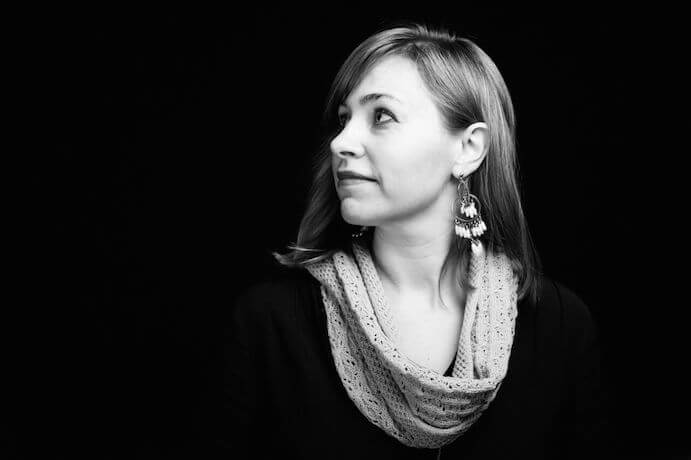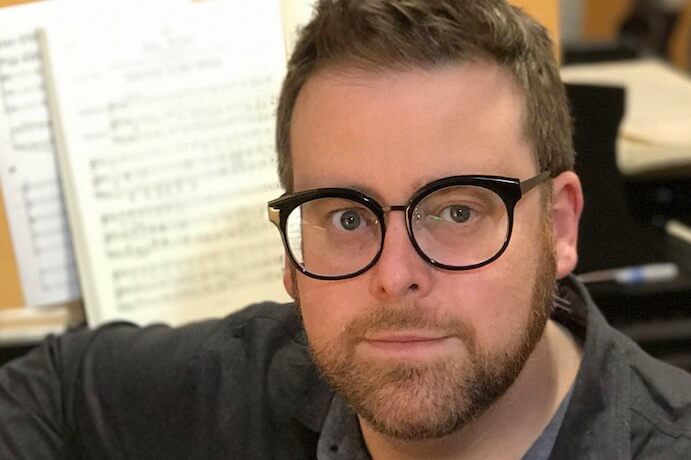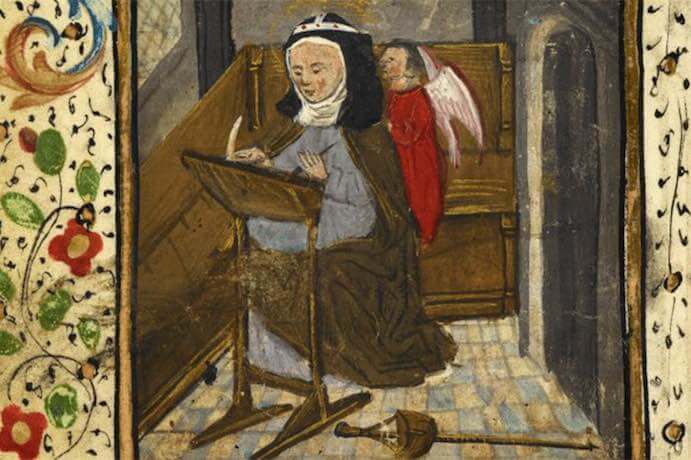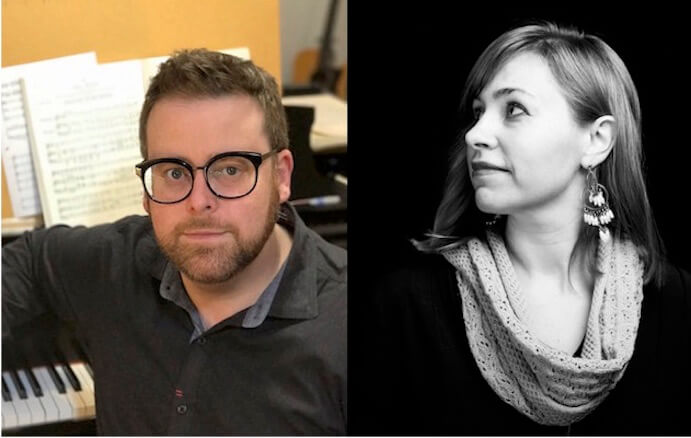Katie Ford’s poetry probes the “spiritual cost of survival” (New York Times Book Review)—an equally apt description of her latest collaboration with composer David Ludwig. Their new monodrama, The Anchoress, depicts a medieval mystic, who spends her life permanently walled inside a small cell. The Anchoress will premiere on October 17 at the Kimmel Center in Philadelphia and will be performed the following day at The DiMenna Center for Classical Music in New York City.
The piece fuses ancient and modern elements through its narrative and through its orchestration for soprano Hyunah Yu, Piffaro: The Renaissance Band, and PRISM saxophone quartet. Ludwig’s previous work of ancient-modern alchemy, Josquin Microludes (also written for PRISM), will be performed alongside The Anchoress at the monodrama’s premiere. The program will also include Ford and Ludwig’s previous collaboration with Yu, Our Long War, and works by Machaut and others that Ludwig has arranged for Piffaro.
Katie, what is it like to hear your words in David’s music? David, what is it like to be a musical steward of Katie’s poetry?
K: It’s an amazing surprise, as I never hear the piece prior to the premiere. I hear it for the first time along with the audience. When I write the poems, they have a quiet privacy. I’ve only heard them in my own voice, so to hear them sung and accompanied by such masterful musicians is a nearly startling to me. The difference! I also regard the composition as another piece of art. I don’t hear it as my art set to music. I hear it as David’s art. My words, in a way, are one of his instruments. It’s quite humbling to have my poems studied and set by David, whose work is stunning to me.
D: “Steward” is an interesting word, and in the sense of feeling a great responsibility in setting the words, I certainly do! But I see myself as framing the words more than guiding them into the music—really they are guiding me in setting them. This is Katie’s story, her character, and so in that way I am doing my best to serve her vision in the music. Her words are so elegant, but they are also visceral and direct; I find this text haunting me every day I spend with it, and it will long after the piece is premiered.

Katie Ford–Photo by Helge Brekke
How has your collaborative process evolved since Our Long War and through the creation of The Anchoress?
K: The Anchoress was more involved than our prior collaborations, not only because it’s a sequence of poems but because the context and the anchoress’ language is archaic, so David and I had very long, wonderful conversations all summer about the anchoress. He had questions in places where the language was a little obscure, or the meaning rather hidden. It’s not that I was translating the poems for him. We were thinking through the language together, and, frankly, he caught places where I had omitted crucial information or little bridges of thought in my own editing, forgetting that the reader would have no idea what I meant if that language was permanently erased. I loved our conversations.
D: Every time Our Long War is performed, people come up to talk to me afterward about the message of the poem and the music, so it feels like a success to me and is one of the pieces I’m most proud of. But this is a collaboration on a much larger scale, and the nature of our conversation about the work changed to consider the whole arc of the piece and the movement from one song to another. I feel both lucky and grateful to have Katie as a collaborative partner–to get to know her work so well from the inside is a privilege. I think the most effective aspect of our communication is that it’s direct and honest, and she’s given me some clear feedback on my musical ideas that has helped me focus and improve them a great deal in the process.
David, in what ways has the story of The Anchoress suggested ways of approaching Piffaro’s and PRISM’s different worlds of sound?
Katie’s text lives in both the medieval world of the anchoress and our contemporary world of concerns as a society, so her vivid images speak directly to me as the composer and I think translate beautifully into sound for the two ensembles (which themselves sit on either end of music history). One example is something wonderful Katie adds—more, subtracts from the text: when the anchoress speaks of something heretical or antithetical to church doctrine, Katie has redacted those words. My response is not to have silence in those spaces, but loud and brassy noise from the saxophones, as if to erase any possibility of hearing what she might be saying at that moment—her voice drowned out by authority. Other than that, the language itself lends itself to multiple perceptions (like great music) and has many references to medieval life and scripture that carry over so well into the ancient instruments—or saxophones acting like ancient instruments. The opportunities to write sonorities I’ve never heard before are quite limitless!

David Ludwig–Photo by Bella Hristova
Katie, would you describe the kind of life an anchoress might have led and how you approach such conditions in your poetry?
She lives in an “anchorhold”—a permanently sealed, small cell attached to the sidewall of a sanctuary. She has one small window through which to speak to townspeople coming to her for guidance. She also has what was called a “squint,” a crack through which she can see the Mass take place. Her daily life resembles a meditative funereal rite. She has withdrawn and chosen a form of death, a choice that transforms her into a living saint. To become an anchoress is a choice against becoming a wife, a servant, a communal nun, or a prostitute—the other options of her time. The authority granted to the female anchoress, in contrast to her alternatives, cannot be overspoken. Perhaps this is why anchoresses outnumbered their male counterparts, anchorites, 4:1.
Very often, anchorholds contain an open grave. The anchoress contemplates not only how to live, but also how to die. The content of what I’ve written has to do with the condition of mind the anchorhold and its seclusion yields. I’m interested in what such an extreme architecture of chosen solitude does to the voice. What is said from this extremity? What can be thought there? The anchoress speaks from a position of authority, yet she isn’t an oracle. My anchoress has doubt, uncertainty, and she says things that are unorthodox and subversive. This is the tension that brought me most deeply into this work. A poem could be imagined as an anchorhold: a containment, a structure, a voice trying to say what she can about life.

Painting of an anchoress
What aspects of The Anchoress do you hope will speak to today’s world, even as we are nearly a millennium removed from the story?
D: There’s really nothing objective I can add to what Katie so beautifully writes below, but I can say that part of what appealed to me personally in the story of the anchoress is the act of complete withdrawal from society and worldly concerns and distractions. The idea of such profound solitude is very compelling to me in theory, but of course not in such extreme practice. Certainly, our political climate makes me and so many people I know want to retreat into isolation—but artists who (unlike the anchorites) are in a position to speak out need to do so. Katie’s words are just so powerful and absolutely relevant as much as any time in my life that I’ve seen, and I want the music to project that power and relevance, as well.
K: With the surge of Christian nationalism in America, I believe more than ever we must have writings that display a diversity of Christianities—not one crystallized creed but a great variety of thought and practice, a variety that has historically been present since the very first moments of the early Christian period. I hope The Anchoress can be one such writing. Further, I believe readers are tired of ironic renderings of faith and doubt, and since poetry will always be a locale in which language presses as far as it can until it reaches the unsayable, and then stands in reverence of the unsayable, a sincerity of posture is warranted. The anchoress, in her confusion and bewilderment, is sincere. She knows she is limited in her knowledge, and she deems the delivery of empty promises an enormous trespass. Her questions are existential, and just as people travel to her cell to seek wisdom through her window, Americans flock to therapists’ offices, they seek the advice of their priest, rabbi, imam, spiritual advisor, life coach, and so forth. Many such forms are secular, but the impulse is the same. We need each other. We need the wisdom another person might be able to offer us.
I also find the particularity of how she has chosen to live out her life profoundly creative, and can remind us that our daily life is a creative act. Creativity isn’t only manifest in art and music. It’s also, perhaps primarily, manifest in how we fashion a life. When we realize this, we know to resist power structures and cultural expectations that put strictures and strangleholds on our creative options. How do you make your life? The 17th century Japanese poet Matsuo Basho voiced it this way: “my neighbor,/ how does he live, I wonder.” It is a question that aches in us all.





















